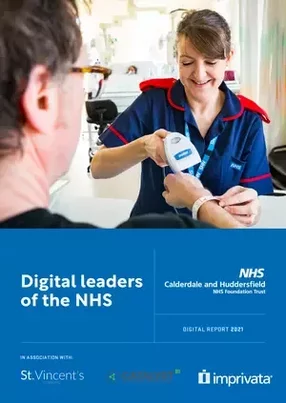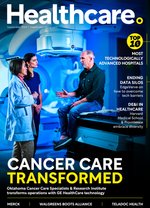The Calderdale and Huddersfield NHS Foundation Trust, situated in West Yorkshire in the north of England, aims to be the most digitally mature NHS trust in the UK. Mandy Griffin, who is the Managing Director for Digital Health, says that they are definitely on their way to achieving this.
A good example is their Electronic Patient Record (EPR). When Griffin became managing Director in 2015 she was handed the board approved business case. It took two years to develop the solution, plan the deployment and engage with staff across the trust before they were ready to adopt to a whole new way of working . "Usually, the technology will work as it is intended, but you need to bring the people that are going to be using it along with you", Griffin explains. We brought all the doctors, nurses and non-clinicians into the fold, so they could really understand how the EPR would change the way they work."
In some cases, this meant explaining the key benefits to people who might be resistant to change, but while tough, Griffin explains the project has been a big success. "It was branded one of the biggest deployments in Europe as far as a Cerner Millennium product is concerned. Now people often come to us to ask us to share our experiences because they want to do the same thing. It's almost become a blueprint for how you should deploy an EPR," she says.
The pandemic sped up the other parts of their digital strategy. "COVID-19 has been a challenge for us all, but it really accelerated our digital maturity and enabled us to achieve more in 12 months than we would ordinarily," she says.
Their next areas of focus include integration and interoperability. "Our strategy is to have one source of the truth and make sure our peripheral systems are connected into the EPR. One of our best strategies is to share information as widely and broadly as we can, so wherever our patients are being cared for, the healthcare professional has access to that information. We also want our patients to have access to it. We're fortunate because we have digital systems in our hospital that enable us to do that, and in many cases, we're at the forefront of some of that innovation."
Over the last year, the importance of having access to rich data has become clear and has helped inform several of the trust's policies. "Some of the decisions we've made at board level around health inequalities, learning disabilities, and the more deprived parts of our local population have been instrumental in connecting us to patients that need us most. We've been able to connect with patients, relatives, and clinicians on a more virtual basis, which wouldn't have happened so quickly if it had not been for the pandemic, or having the benefit of a well embedded clinical system.
"Our work on health inequalities is a great example of population health", she adds. "I think it's become a very trendy term, but without a platform like ours, there is no population health because there's no real-time data. Because we've now got that real-time data that comes in from all our systems, and not just from EPR, we're better informed. We understand our patient population, we understand our patient needs, and we understand where there is a prevalence of different illnesses across our population."
Without Catalyst BI (previously Qlick IT) this would not have been possible. We have worked with Catalyst for as long as 10 years now. They have been our suppliers for Qlikview and QlikSense, the Business Intelligence software on which The Health Informatics Service (THIS) Information teams have put together the Knowledge Portal and Knowledge Portal plus solutions.
These solutions provide information to hundreds of users across the organisation, ranging from live dashboards detailing the current activity within the hospital to nightly fed reporting solutions covering a range of service areas. The coverage (user base numbers) and facilities (number of applications and different data sources) has grown year on year.
Having a digital identity supports fast access to patient information. “It enables a faster but controlled access to important information whilst protecting patient/sensitive data” Griffin says. “Rapid access to information anywhere anytime is a critical element of good patient care, improving the patient experience as well as the experience of the health professional.”
It is also a key enabler of the virtual care that has been indispensable throughout the pandemic. “It actually meets statutory standards around more complex and varied data sharing such as remote and virtual care. This is important now that healthcare organisations are expanding the use of virtual care especially since the pandemic.”
Griffin adds that having a digital identity can also prevent cyberattacks. “Using a digital identity will mitigate against possible cyberattacks and protect sensitive data in line with essential cyber standards and those put in place by NHS Digital. It also supports the requirements of the Data Security and protection toolkit.”
On a national level, the trust has been involved in the Scan4Safety programme, which has the aim of improving traceability through the use of barcodes. "Thanks to funding from Scan4Safety, we've introduced products and solutions that have really enhanced patient safety, and we were able to procure an asset tracking system to identify critical equipment needed for the care of our patients", Griffin explains.
The project has proven very valuable as the trust has now tagged over 3,000 devices. "We can track where equipment is, and we can get it to where it needs to be as quickly and as efficiently as possible", Griffin says. "Scan4safety is a collaboration across West Yorkshire led by Leeds Teaching Hospital, where we have procured a joint inventory system that will allow us to track and see where all our products across our trusts are at any one given time. It's still in its infancy, but the whole aim is that by the end of the Scan4Safety programme, there will be a shared inventory solution across the West Yorkshire Association of Acute Trusts."
Behind the scenes, Griffin and her team had a lot of work to do when the pandemic began. Within two weeks, they had transitioned over 2,000 employees to work from home, which required increasing the available bandwidth so the workforce could use Microsoft Teams to stay connected. "That was quite a challenge, but it was a challenge that we met," she says.
With THIS, Griffin and her team enabled this to happen across all the organisations they support. THIS provides information management and technical support to a number of customers, predominantly in West Yorkshire. It also manages the National Pathology Exchange (NPEx), a service that links all UK labs together through a single hub so that any lab can send test requests and pathology results digitally in minutes. "During the pandemic, we connected all 160 labs across the NHS, and it's been a fantastic success. We were very instrumental in making sure that the goal of 100,000 COVID-19 tests a day was delivered nationally."
"What I'm most proud of is how the 200 staff that work for THIS pulled together to mobilise things like the vaccination centres and the testing centres. Technology underpins all those centres. We literally stood up every single one of those across the West Yorkshire area."
Once the pandemic subsides, some of their new ways of working are likely to remain, such as virtual consultations. "Virtual care was always an aspiration, but it became a necessity when COVID hit", explains Graham Walsh, Chief Clinical Information Officer.
"We very quickly started using Microsoft Teams to do some of those virtual consultations, and we found that clinicians adopted the change well, but also that patients really embraced it.
"Before COVID there was a fear that patients wouldn't have that richness of an experience through a virtual consultation, but actually we found that because they didn't need to park their car to come to an appointment, and sit for two hours in a waiting room when the clinic was over-running, their experience was better."
The trust partnered with a company that integrated well with Teams and the EPR, making it possible to launch a virtual consultation from the appointment window. It improved both the patient and the clinicians’ experience of Teams consultations. Mr Walsh says this made a big difference to user acceptance.
Through an existing partnership with St Vincent's Consulting, they developed a solution for the rapidly increasing patient backlog created by the pandemic. The tool integrates with the EPR and allows clinicians to view a list of cancelled appointments, check the patients’ record and make informed decisions on their follow up based on clinical need. Additionally, the trust is having conversations with the company about an end-to-end solution to make the outpatient experience in the hospital more efficient.
The trust has also been exploring the use of wearable technology to try and improve post-operative care. "This speeds up their discharge and reduces their need for face-to- face follow up with therapy services as they can be monitored remotely and communicate through a dashboard. This allows therapy services to focus on those patients that need their input and allow them to act at an early stage identifying issues before they become problems.”
Patients can wear a device that monitors their postoperative range of movements and compliance with their recovery goals. Walsh says that outcomes have actually improved since doing this monitoring remotely. "It's interesting that the NHS is looking at the work we've done with our wearable technology and are considering using this nationally in a much bigger project," he says.
"Some of the work that we've done has inspired other units to do some of the same, but I think overriding everything, what we found is that COVID forced us into this virtual world as clinicians and accelerated the acceptance of technology when before it was always seen as something that was going to add time and be an inconvenience. I think it allowed us to bring those changes in quickly because people realised that it did make their working day easier."
Now that virtual consultations are in place, they are looking at ways to enrich the patient experience. "We could pull in things like X-rays and blood test results that can be shared with the patient. We could bring in other professionals. For example, when I see a patient following a knee replacement, I might want to bring a physiotherapist into that conversation. In a fertility setting, you might want to bring in a relative."
Technology has been a huge enabler for relatives and friends to keep in touch with people in hospital while visiting has been restricted. "We bought in a device at a pace that was COVID safe, so it could be passed around from patient to patient and be cleaned in-between", Walsh says. "Other trusts struggled at the beginning to find how they could do this, and I think at Calderdale we found a solution fairly rapidly that satisfied all our infection control needs."
As the UK hopefully shifts out of the pandemic, the trust aims to continue its digital journey, focused on interoperability, integration and data sharing, as well as getting people within the organisation to use the systems and technology better. "Moving away from the horrible experience of the disease itself, we need to make sure we don't forget the lessons learned", Walsh says, "and that we don't revert back to where we were, and we keep our progress going.


